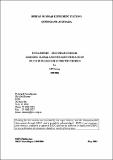| Abstract | There has been a negative trend in CCS in the Tully-Mossman region since the mid-1960s that has been linked to increased extraneous matter and suckers in the cane supply. The situation had become particularly bad during 1990-1996, with most mill districts within the region experiencing problems with low CCS. An increase in the frequency of lodging and incidence of suckers was possibly contributing to this problem and there was a perception that this was related to inappropriate use of nitrogen fertiliser for the locally grown cultivars. There were also concerns that current cultivars were not suited to the local environmental conditions. Growers choosing to grow inappropriate cultivars for particular locations were thought to be exacerbating the problem.Decisions on what cultivar to grow and how much fertiliser to apply are management options that could be modified if they were contributing to the low CCS problem. These issues were addressed in this project by studying the effects of four rates of nitrogen (0, 70, 140, 210 kg N/ha) on lodging, suckering, CCS and cane yield of the three cultivars Q117, Q120 and Q138. These experiments were conducted on three different soil types at three locations within the Tully mill district. The objectives of this project were to provide a better understanding of the role of nitrogen and cultivars in the low CCS issue to facilitate the development of improved management options.In the plant crops, which were planted after a fallow, nitrogen had no influence on cane yield, CCS, lodging or suckering under the environmental conditions in which these crops were grown. However, it did increase both cane yield and lodging in first- and second-ratoon crops. Responses were limited by adverse interactions with the wet conditions and nitrogen losses due to leaching and/or volatilisation. Nitrogen had no direct influence on CCS in the ratoon crops, but it did have an indirect negative effect, because it increased the incidence of lodging. Rates of N application could be reduced in both plant and ratoon crops, which would reduce production costs. It would also be beneficial environmentally.There was no evidence of nitrogen accumulation in the soil from high nitrogen fertiliser application even following a low-yielding crop. This is of concern from an environmental viewpoint if inappropriate nitrogen rates are applied, as any excess nitrogen will be lost from the soil due to leaching or denitrification. The data suggested that the critical leaf nitrogen concentration might vary between cultivars. This provides an opportunity to reduce nitrogen rates for cultivars with lower nitrogen requirements.Current cultivars do have high potential CCS, but this cannot be realised, partially because of their susceptibility to lodging and suckering. All three cultivars tested, Q117, Q120 and Q138, are susceptible to lodging in well-grown crops. It appears that the susceptibility of Q120 and Q138 is high in crops yielding more than 70-80 t/ha under the wet conditions of the wet tropics.The potential reduction in CCS from total lodging was estimated at about 10% across all cultivars in these trials. The actual loss in CCS is governed by the actual proportion of lodging in the crop and was estimated at 0.4 units in crops that had 25% lodging. This is a hidden cost of which growers are generally not aware. There are no management options that can be implemented to minimise this loss. Severe and multiple lodging events had a negative impact on CCS and cane yield in Q120 and Q138, reducing profitability. In these circumstances, the negative effects of lodging can be reduced if the time between harvesting and occurrence of lodging is reduced. Increased returns to the grower of $200 $300/ha are possible using this strategy.Lodging was less extensive in Q117 and lower-vigour cultivars, such as Q117, may offer a more appropriate ideotype for the wet tropics, because of their lower susceptibility to lodging. Economic impact was estimated at a loss of $7.5 million to growers within the region from a moderate lodging event affecting 25% of the crop. Adoption of agronomic practices to improve physical support of the crop is only partially successful in reducing the intensity of lodging. This can only be achieved by the implementation of a research program to select cultivars with a low incidence of lodging, while maintaining or improving productivity.The cultivars Q117, Q120 and Q138 are representative of those being grown in the wet tropics and demonstrated a high propensity to sucker. Lodging is not a pre-requisite for sucker initiation, as the emergence of suckers was generally first noted under a closed canopy. Suckers have a negative effect on CCS, because they dilute the cane juice through their high moisture and low sucrose composition. In these experiments, 10% by weight of suckers in the cane supply reduced CCS by a little over 1 unit. The increased cane yield from suckers is inflating productivity estimates but not improving profitability; the level of suckering experienced in these experiments would reduce regional grower-income by approximately $6 million. It is possible to select against suckering propensity and this has already been introduced into the crop improvement program. However, research into the relationship between suckers and longevity of ratoons is required because of the potential impact on productivity.An appropriate extension program needs to be developed to disseminate the findings of this research to growers. The results from this project have been extended to the industry. There have also been extension programs for BMP of cultivars. However, there is still a large gap between extension and adoption, which is why additional extension programs are recommended. Adoption of findings on nitrogen will reduce production costs, as well as have a positive environmental impact. Management strategies are available to partially alleviate the negative impacts of lodging and suckering. However, further research is required to fully overcome the effects of these phenomena. |

